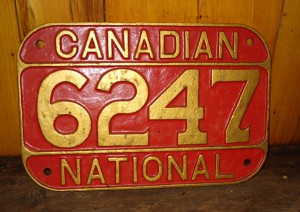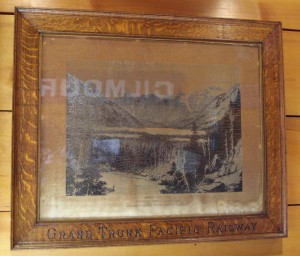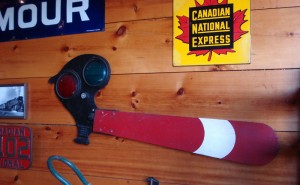Exploring the Walmsley Collection – Number Plate, Picture & Train Order Board Signal


 Click on each picture for a closer look!
Click on each picture for a closer look!
.
Continuing with our presentation of artefacts from the David A. Walmsley collection, we present the following:
- STEAM LOCOMOTIVE NUMBER PLATE #6247: When the Canadian Northern Railway was amalgamated into the Canadian National Railway System in January 1923, the newly formed company adopted the locomotive number plate as designed for identification and use on Canadian Northern steam power. The word ‘Northern’ was replaced with the word ‘National’ reflecting the name change. This design remained on CNR power until steam was officially retired in early 1960. Plate number 6247 is an example of a U-2-h class Northern 4-8-4 type engine, the same wheel arrangement as our U-2-g class engine 6213.
- GRAND TRUNK PACIFIC RAILWAY: Framed picture titled ‘Moose Lake B.C.,Canadian Rocky Mountains, Canada’s Grand Trunk Pacific Railway’: This is an example of railway decor from the very early decades of railroading in Canada. While many of these frames were made of hardwood such as oak, this one appears to be made of chestnut. The railway name was most likely stamped, perhaps with a hot embossing plate under pressure, which appears to have compressed and burned the fibres of the wood. They would usually contain a very early image of spectacular scenes through which the railway operated, sometimes as viewed from the train window. Most often they were displayed in railway offices and stations. One lettered for Canadian Pacific Railway could be found on the wall of the CPR Bolton, Ontario station late into the 1960’s.
- TRAIN ORDER BOARD SIGNAL : This operational tool represents an early form of train signal used at stations to indicate to train crews that they must stop, or have the right to proceed. One such station that used the two aspect configuration of only displaying red and green was our own Don station, which never received a three aspect signal board. Under instructions from the train dispatcher, the Station Agent or train order Operator would be instructed as to the signal required to be displayed. If the signal was at ‘stop’, the engine would not be allowed to pass until the proper authority was issued by the Train Dispatcher and orders received by the train crew. Order Board signals without the third aspect of yellow, were allowed to supplement a yellow flag by day, and a yellow flag and lantern by night. Our collection now includes both types of train order board signals. Some will be placed into operation at the appropriate locations..
Posting and pictures by John Mellow
http://www.trha.ca

